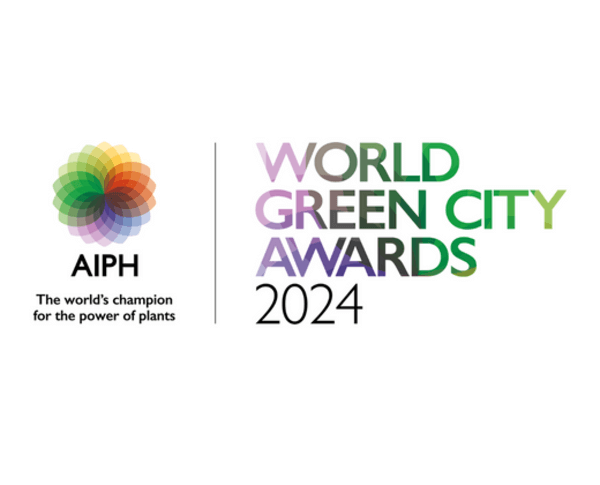 - © Montréal Botanical Garden
- © Montréal Botanical Garden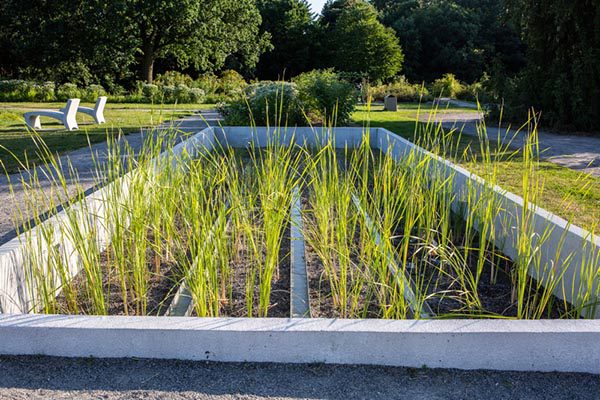 - © Montréal Botanical Garden
- © Montréal Botanical Garden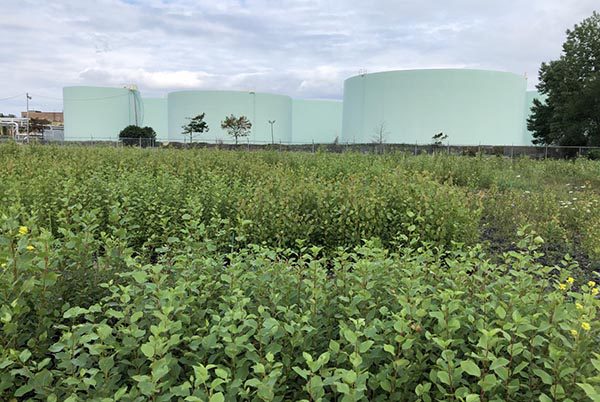 - © Montréal Botanical Garden
- © Montréal Botanical Garden - © Montréal Botanical Garden
- © Montréal Botanical Garden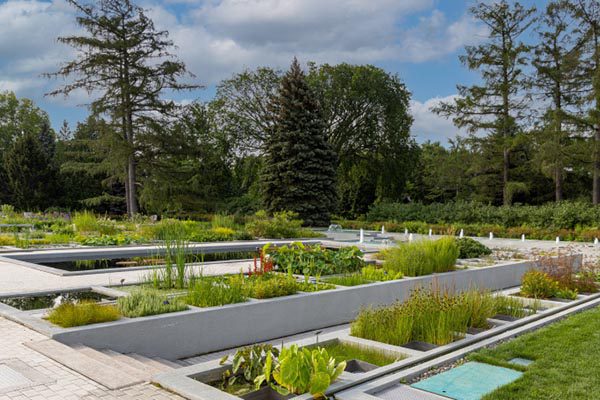 - © Montréal Botanical Garden
- © Montréal Botanical Garden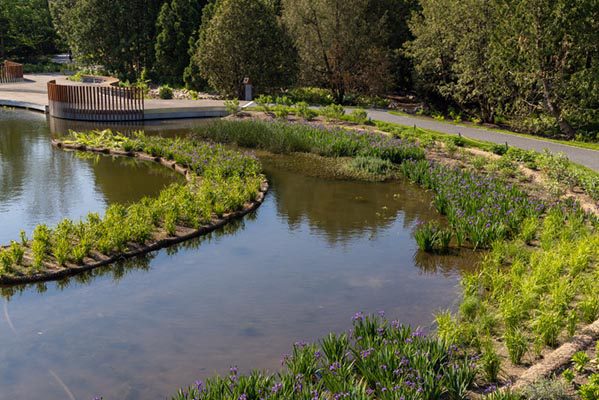 - © Montréal Botanical Garden
- © Montréal Botanical Garden
City
Montréal
Main actors
City Government, Private Sector, Community / Citizen Group
Project area
Inner City
Duration
Ongoing since 2019
Cities worldwide are facing environmental challenges, and the use of plants to solve these issues is an innovative and sustainable solution. The Phytotechnology Stations were designed to provide a suite of solutions to some of Montréal Botanical Garden’s environmental problems, many of which are directly transferable to the City of Montréal, and its citizens. Plant-based solutions are low input for the organization implementing them but provide multiple benefits for citizens. The increase in vegetation cover generates exosystemic services, provides habitat for wildlife, reduces heat islands, controls water runoff, and captures atmospheric carbon. Because they address common challenges facing cities, the solutions displayed are replicable by cities around the world, as well as companies and citizens. As such, stimulating the deployment of phytotechnologys stimulates the creation of green, plant-based expertise and start-ups.
Originally published by AIPH World Green City Awards: Link to case study
AIPH World Green City Awards
This project was awarded the 'AIPH World Green City Awards' in 2022 in the following category: Living Green for Water.
With its collection of about 20,000 plant species and cultivars and 30 topical gardens spread out over 75 hectares, the Montréal Botanical Garden is recognized as one of the world’s greatest botanical gardens. The Botanical Garden is part of Space for Life, a group of five institutions that together make up the largest museum complex in Canada.
Widely recognized as a perfect place to enjoy the natural beauty of the world of plants, the Botanical Garden is also distinguished by its numerous initiatives in the field of phytotechnologys: using plants to solve environmental problems such as purifying air, water and soil, controlling erosion and run-off, and helping to remediate degraded sites.
In recent years, the Montréal Botanical Garden has set up a series of phytotechnology stations to address various environmental issues that exist on its site. The idea is to design installations that simultaneously solve the problems, demonstrate the technology, and educate the public as to the role and functioning of the plants.
The first station was inaugurated in 2019. The Botanical Garden took advantage of the renovation of the aquatic garden, which presents a diversity of aquatic plant species, to include two different types of sub-surface constructed wetlands, one with horizontal flow and one with vertical flow. These wetlands ensure the water used in this garden, which circulates in a closed circuit, is of good quality. The innovation not only ensures the removal of phosphorus and nitrogen surpluses and the reduction of suspended solids, but also educates visitors on the role and benefits provided by these green infrastructures.
In 2021, the Garden opened a second phytotechnology station to address a problem related to invasion by undesirable plants. Among the phytotechnologys used, a riparian strip involving a great diversity of native plants was established as a buffer. This has the effect of opposing strong competition to invasive plants while acting as an effective biofilter that limits the leaching of nutrients brought by the runoff of rainwater. Floating islands in the form of mattresses woven of plants have also been installed. This original phytotechnology makes it possible to add filtering elements that move on the pond according to the winds. It's aesthetically pleasing, but it's also effective in making it more difficult for invasive plants that require sunlight to establish themselves.
The plan is to set up six phytotechnology stations over the next few years, inaugurated one at a time, and completed by 2026.
The Phytotechnology Stations project was carried out in close collaboration with the research department of the Montréal Botanical Garden and involved scientists recognized worldwide for their expertise in this field. The design of each of these Stations was based on this scientific knowledge of plant biology. The principle of phytotechnologys uses the physiological characteristics of plants to maximize their potential to provide benefits and services, such as the extraction of contaminants from the soil, the stabilization of soils and reduction of erosion, and the exploitation of their transpiration capacity to treat runoff.
The establishment of Phytotechnology Stations at the Botanical Garden enables the solving of environmental problems, while simultaneously providing elements of education and demonstration. Each station has educational elements that explain the role and function of plants with the help of display boards. This also makes visitors (800,000 per year) aware of the importance of these green technologies as a new approach and encourages their application in domestic, municipal and industrial contexts.
The design work for the Phytotechnology Stations involved people from a variety of disciplines, including plant biologists specializing in phytotechnologys from the Botanical Garden and the Université de Montréal, engineers, and horticulturists who advised on the right plant choices.
The initiative was conceived based on years of research by the garden’s team of scientists, all of whom are world leaders in the field of plant-based solutions. The team has conducted several projects for soil decontamination and has constructed wetlands and revegetalization initiatives across the Québec province and the City of Montréal. It is worth noting that the “Parc-Plage of the parc Jean-Drapeau”, a safe and clean swimming area in the middle of the St-Lawrence River, is a long-term demonstration of the success of a plant-based project. The water quality is significantly improved by a plant-based system installed by city employees and scientists. In the east of the island, a particularly industrialized sector, a 4-hectare-pilot-scale phytoremediation experiment was set up by the scientific team of the Curator of the Botanical Garden. It constitutes a green lung for the neighbourhood which serves the population.
Each station in the Botanical garden is followed by the scientific team and is the subject of study of several graduate students at the Institute de biologie végétale (plant biology research centre) at the University of Montréal. A special effort is made to choose resilient, indigenous and non-invasive plants, and this selection is based on long-term climate forecasts. A follow-up on the establishment and state of health of the plant communities is also carried out.
The City of Montréal has committed the necessary funds in its long-term planning strategy. The Montréal Botanical Garden has created a full-time scientist position to oversee the effectiveness of the project and its implementation. A landscape architect, specialized horticulturists and gardeners support this position. Financial partners from the industrial sector sponsored the construction of some of the Stations.
The establishment of the first phytotechnology stations was made possible thanks to the economic support of Québec companies which invested several hundred thousand dollars through the Space for Life Foundation.
All the facilities comprising the Phytotechnology Stations showcase the potential of plants to solve an environmental problem. This is the very principle of phytotechnologys. As a result, the use of plants indirectly generates a set of ecological benefits. For example, the establishment of a Soil Decontamination Station aims primarily to use plants to rehabilitate polluted soils. However, the use of plants also allows the creation of green spaces that contribute to absorbing greenhouse gases, create oases of coolness, increase biodiversity, and improve the landscape.
Today, the entire Québec community is benefiting from this initiative, and several unexpected initiatives are being developed: not only are the stations places of research for several graduate students, but they are also the central place of animation of several day camps for the children of Montréal. The Québec society of phytotechnology also uses the course as support of demonstration for its activities of diffusion.
In an even more original way, a true partnership with the National Film Board of Canada has been established to retrace the evolution of the decontamination stations, their renaturalization, and the phytotechnologys that are put forward over the years.
Phytotechnologys are all good alternatives to conventional engineering processes. The use of plants thus has positive effects on the reduction of greenhouse gases and the use of products of fossil origin. Whenever plants are used in the provision of green infrastructure, they contribute significantly, through their photosynthesis, to the absorption of CO2, which also has a direct effect on the carbon footprint of these initiatives.
All the stations are monitored, not only to document the efficiency of these green infrastructure solutions, but also to improve the processes specific to each of the phytotechnologys used. This is done by measuring plant growth and productivity and certain physiological parameters, by monitoring physio-chemical changes in water or soil, and by sampling soils and/or water to assess variations in microbial communities. Wherever necessary, adjustments are made, such as modifications to the plant species used, soil amendments, and changes in flow rates. The Stations are small living laboratories that allow graduate students to carry out master's or doctoral projects under the supervision of Botanical Garden researchers.
Soil contamination, wastewater, invasive plant species, and heat islands are among the many serious problems that affect the quality of life and health of urban citizens worldwide. Moreover, the economic and social impacts that result from these issues are significant burdens for both public and private organizations.
It is interesting to note that the ideas presented through these Phytotechnology Stations have been taken up and applied in certain areas of the City of Montréal to address concrete problems. The phytoremediation project on four hectares of brownfields in the east end of the City of Montréal is one of the most notable examples.
Cities around the world are facing an increase in serious environmental challenges. The use of plants to solve these issues is increasingly becoming an innovative and sustainable solution. The initiative was conceived as an exemplary set of solutions to some of the problems of the Montréal Botanical Garden. These solutions are directly transferable to the entire City of Montréal and its citizens, and the concept can be adapted and implemented by cities around the world as well as companies and citizens.
For example, the team of the Montréal Botanical Garden has developed a partnership with the Shanghai Botanical Garden to co-create solutions adapted to China. The initiative was also the subject of a presentation which was given in 2018 in the Basque Country, providing a source of inspiration for the City of Vitoria-Gasteiz which now relies on similar approaches for the development of their sustainable neighbourhoods.
On Map
The Map will be displayed after accepting cookie policy
